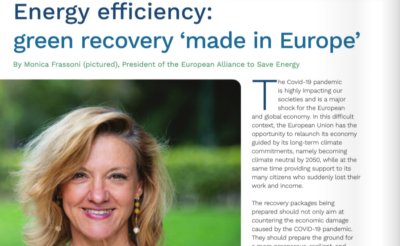The great potential of non-residential buildings and how to tap into it

Decarbonising non-residential buildings is crucial to meet Europe’s carbon neutrality goal by 2050. To do so, and in view of the upcoming Renovation Wave, Member States should focus on the ambitious implementation of the EPBD and produce renovation strategies targeted also to this sector.
There are many reasons why making also non-residential buildings energy efficient should be among the priorities for the European Union and its Member States. The share of non-residential buildings in the total EU building stock is just 25%, but they require in average 55% more energy than residential buildings. Take Germany, for example, non-residential buildings (excluding industry and trade) are the smallest group in terms of numbers, at around 2.7 million units. However, due to their larger area per building they represent the second largest group in terms of building energy consumption (36%).
Decarbonising non-residential buildings is advantageous because, due to their nature, ownership structure and the high energy demand schools, hospitals and offices are ideally suited to help shape important paths for a future-oriented energy system based on energy efficiency, digitalisation, and an increasing role of “prosumers”.
Indeed, in 90% of cases, the energy efficiency potential of those buildings can be realized economically within their life cycle. The technologies required for this have been available for a long time and are constantly being enhanced by the industry. These include systems for energy-efficient management of indoor air quality, thermal comfort, integration of renewable energies, electromobility, as well as for workplace management.
In addition to the energy-efficient renovation of the building envelop, investments in building automation technologies offer savings in energy and cost of around 30%, with payback periods between 6 months and 3 years.
To achieve these figures, all technical systems in a non-residential building should be coordinated to go beyond their individual functions in order to optimize the energy productivity. This can be done through the harmonization of demand and supply energy flows, and the proactive management of thermal and electrical storage. Doing so would enable the integration of renewables even on a small scale as well as the application of various demand side management strategies.
In this perspective, a coherent modernization and digitalisation of the energy infrastructure of non-residential buildings will support the transformation of the energy system and the active implementation of the EU’s climate protection policy. The advancing digitalisation in the building sector will be the determining pathfinder for more energy efficiency in the future and will pave the way for grid-interactive efficient intelligent buildings.
Smart buildings integrate technology and equipment to proactively predict faults, monitor performance in real time, and provide predictive insights regarding building systems and facilities, including power management, energy usage, and occupant comfort.
The revised EPBD set out a clear path towards achieving a stock of low and zero-emission buildings in the Union by 2050. This path is based on national roadmaps with intermediate targets and progress indicators, with public and private funding and investment. An ambitious EPBD implementation and financially sound renovation strategies for non-residential buildings are needed to kick-start the Renovation Wave.
In this context, buildings should no longer be considered as pure energy consumers but as active players and dynamic assets in the future, climate-neutral energy system.
This article was written by Bonnie Brook, Vice-chair of the Board of the European Alliance to Save Energy and Senior Manager Industry Affairs at Siemens, and Volker Dragon, Senior Manager Industry Affairs at Siemens.





